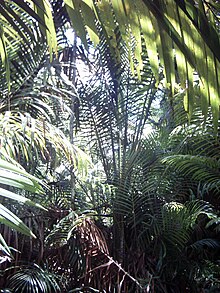
Back ساغو Arabic Сага (крупы) Byelorussian Сага (крупы) BE-X-OLD সাগু Bengali/Bangla Sagú Catalan Ságo Czech Sago Danish Sago German Sagu DTP ސާގު DV
This article includes a list of general references, but it lacks sufficient corresponding inline citations. (April 2009) |


Sago (/ˈseɪɡoʊ/) is a starch extracted from the pith, or spongy core tissue, of various tropical palm stems, especially those of Metroxylon sagu.[1] It is a major staple food for the lowland peoples of New Guinea and the Maluku Islands, where it is called saksak, rabia and sagu. The largest supply of sago comes from Southeast Asia, particularly Indonesia and Malaysia. Large quantities of sago are sent to Europe and North America for cooking purposes.[2] It is traditionally cooked and eaten in various forms, such as rolled into balls, mixed with boiling water to form a glue-like paste (papeda), or as a pancake.
Sago is often produced commercially in the form of "pearls" (small rounded starch aggregates, partly gelatinized by heating). Sago pearls can be boiled with water or milk and sugar to make a sweet sago pudding.[3] Sago pearls are similar in appearance to the pearled starches of other origin, e.g. cassava starch (tapioca) and potato starch. They may be used interchangeably in some dishes,[4] and tapioca pearls are often marketed as "sago", since they are much cheaper to produce.[5] Compared to tapioca pearls, real sago pearls are off-white, uneven in size, brittle and cook very quickly.[5]
The name sago is also sometimes used for starch extracted from other sources, especially the sago cycad, Cycas revoluta. The sago cycad is also commonly known as the sago palm, although this is a misnomer as cycads are not palms. Extracting edible starch from the sago cycad requires special care due to the poisonous nature of cycads.[6] Cycad sago is used for many of the same purposes as palm sago.
The fruit of palm trees from which the sago is produced is not allowed to ripen fully, as full ripening completes the life cycle of the tree and exhausts the starch reserves in the trunk to produce the seeds to the point of death, leaving a hollow shell. The palms are cut down when they are about 15 years old, just before or shortly after the inflorescence appears. The stems, which grow 10 to 15 meters (35 to 50 feet) high, are split out. The starch-containing pith is taken from the stems and ground to powder. The powder is kneaded in water over a cloth or sieve to release the starch. The water with the starch passes into a trough where the starch settles. After a few washings, the starch is ready to be used in cooking. A single palm yields about 360 kilograms (800 pounds) of dry starch.
- ^ Karim, A. A. (2008). "Starch from the Sago (Metroxylon sagu) Palm Tree—Properties, Prospects, and Challenges as a New Industrial Source for Food and Other Uses" (PDF). Comprehensive Reviews in Food Science and Food Safety. 7 (3): 215–228. doi:10.1111/j.1541-4337.2008.00042.x. PMID 33467803.
- ^ "Flour or meal of sago, starchy roots or tubers (HS: 110620) Product Trade, Exporters and Importers | OEC". OEC - The Observatory of Economic Complexity. Retrieved April 26, 2022.
- ^ "Sago Pudding with Palm Sugar (Sago Gula Melaka)". mycookinghut.com. May 23, 2010. Retrieved March 9, 2011.
- ^ "Learn How to Cook Perfect Tapioca Pearls". The Spruce Eats. Retrieved March 18, 2022.
- ^ a b "Real Sago vs Tapioca Pearls + Sago Pudding Recipe". October 15, 2021.
- ^ Lafferty, Jamie (January 7, 2020). "How a Plant Saved a Japanese Island". BBC.
© MMXXIII Rich X Search. We shall prevail. All rights reserved. Rich X Search